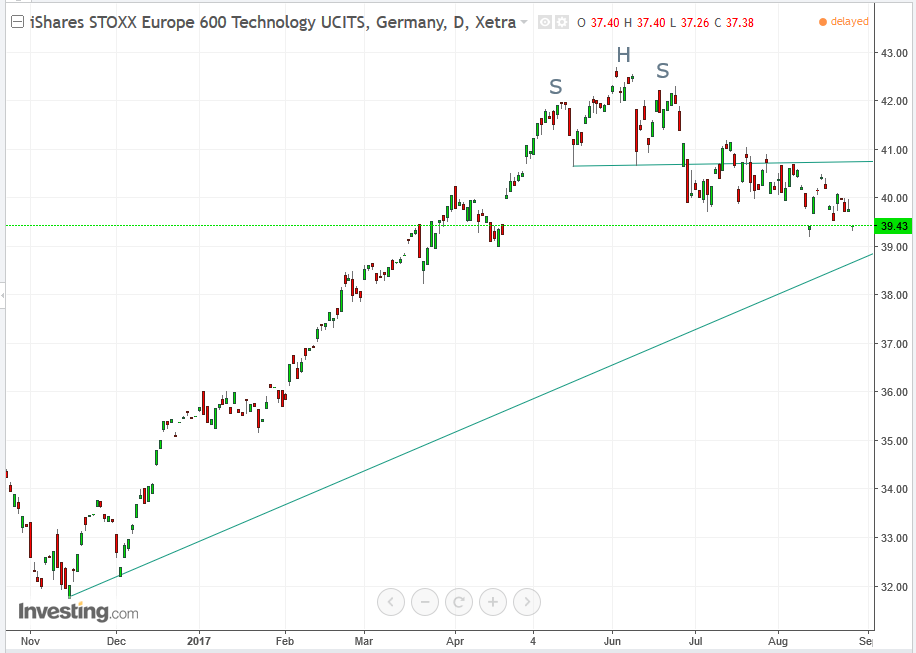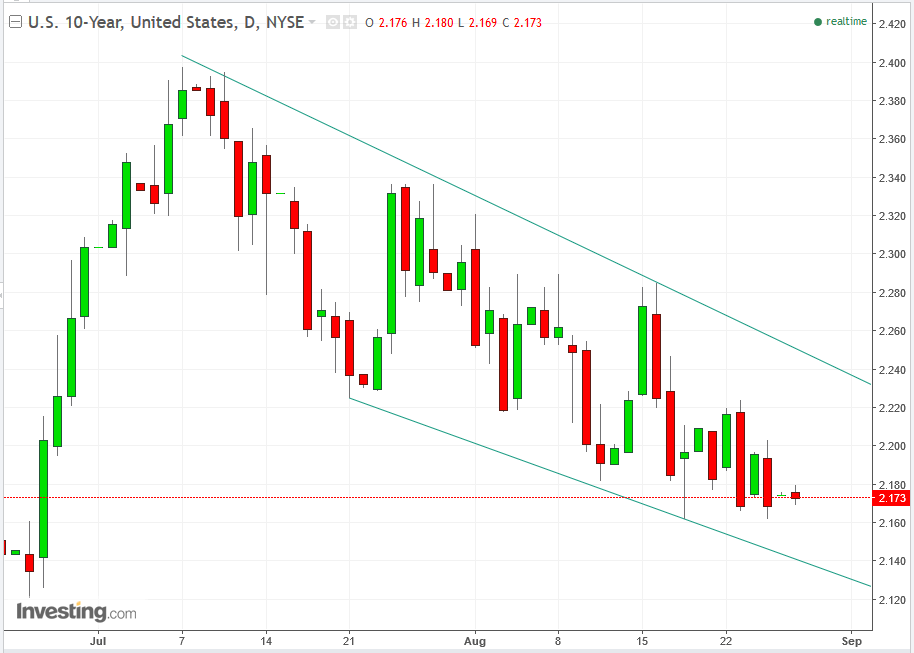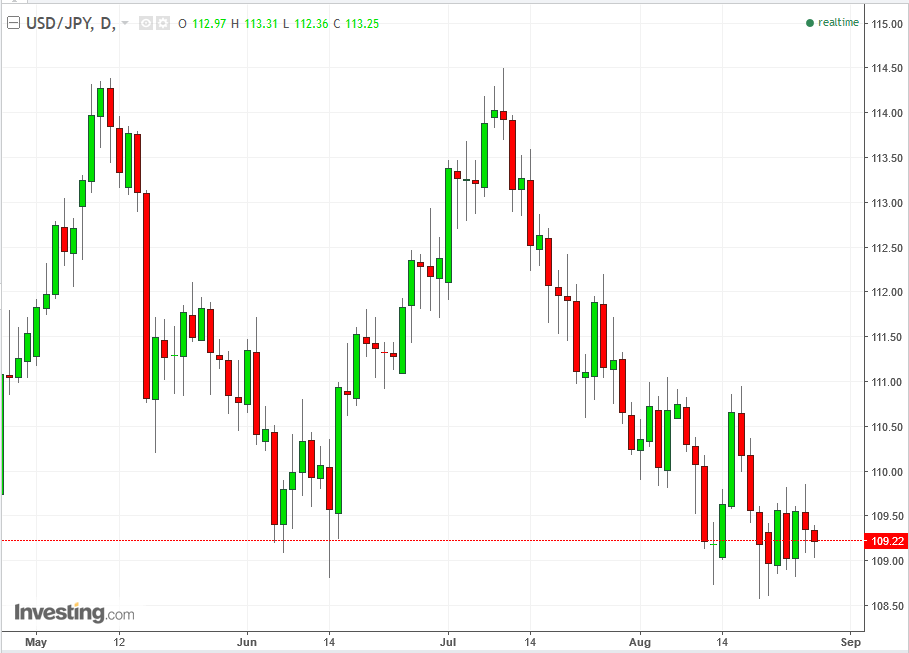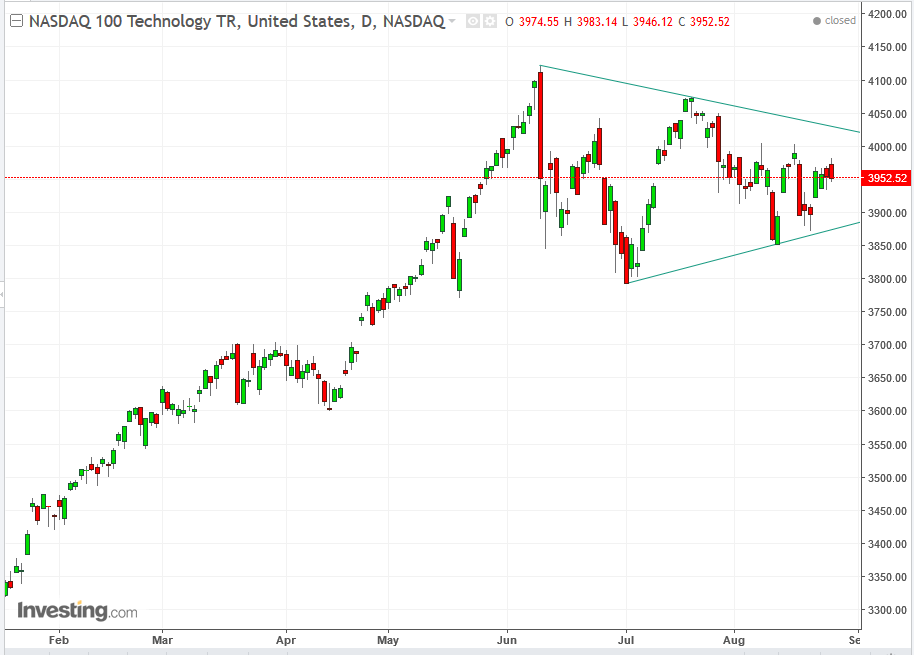by Pinchas Cohen
Key Events
European stocks across the board started the week in retreat, as all sectors are declining on the euro's rise this past Friday. The stronger single currency hurts European stocks right now and will continue to do so in the future, first by making them increasingly expensive for foreign investors to buy, then later by raising the cost to export products, hampering both revenue and profits for European companies.
Global Affairs
The biggest impact of a stronger euro hurting exports can be seen in the multi-national technology sector, and therefore it’s no surprise that the STOXX Europe 600 Index is showing the biggest decline.

The index completed a H&S, which was retested and confirmed. It is now approaching its uptrend line from November 2016 at 39.00.
US futures fell, as the dollar extended its plunge from Friday—a result of the lack of information at the Jackson Hole, Wyoming retreat last week from Fed Chairwoman Janet Yellen regarding the path to rising interest rates or shrinking the balance sheet as well as the silence from ECB President Mario Draghi on the adverse effects of the stronger euro.
As well, the greenback's decline isn't being helped by the potential market ramifications of Tropical Storm Harvey which is currently battering Houston, the US's fourth largest city. Gasoline futures surged as the storm shut more than 10 percent of US fuel-refining capacity.
Investors are now focusing on US tax reform. After so many disappointments stemming from President Donald Trump’s lack of success with his agenda, investors will likely become bullish on any hints of progress. On Friday, Gary Cohen, the Director of the National Economic Council, instilled some optimism among traders when he said he expects tax reform to pass this year and that he didn’t intend to resign over Trump’s comments on the violence in Charlottesville.
Treasury traders' focus is fixed on Tuesday’s auction of Treasury bills that mature on September 29—the deadline Treasury Secretary Steven Mnuchin named critical for raising the debt ceiling. Later this week, investors will shift their focus to inflation and payrolls data, considered key for determining the Fed’s upcoming moves.
In what is emerging as a divided Fed, Federal Reserve Bank of Cleveland President Loretta Mester urged other policy makers to broaden their focus beyond recent weak inflation data and to remain committed to their plan to gradually lift interest rates.
The yen strengthened, Treasury yields dropped and gold rose above the $1,300 key level.
The UK market is closed for a summer bank holiday.
Up Ahead
- The U.S. Treasury will issue $132 billion in notes and bills.

Risk appetite increased as 10-year Treasuries have been trading within a down-channel since July 7. The support from the High Wave Candle—which itself is in a signal of a reversal—since August 18 suggests a consolidation at the support of the channel bottom to a corrective rally toward the downtrend line (channel top), toward 2.220
- 19:30: Japan - Unemployment (July): expected to remain at 2.8% YoY.

The price of the USDJPY pair is near the bottom of its trading range since May 9, providing a long position with a 0.7 percent downside risk to the August 18, 108.58 support low and a 4.7 percent upside potential to the July 1, 114.51 high resistance. That makes the risk-reward ratio 15:1 in favor of a long position. In other words, for every point of risk the potential reward is 15 times that. It’s important to note, this analysis does not predict that the price will necessarily go up, it only highlights the risk-reward ratio.
- The UK is due to resume Brexit talks with the European Union.

The GBPUSD pair bounced off the uptrend line since the October flash crash, suggesting a trend resumption and a retesting of the 1.3300 price level.
- Japan reports jobs data on Tuesday and retail sales figures on Wednesday.
- Hong Kong reports retail sales on Tuesday, while Australia is due to publish data on construction on Wednesday.
- The US updates second-quarter GDP and core price data on Wednesday; it reports on August payrolls on Friday.

The US market sector that has led the overwhelming majority of rallies has been stalling. This can be seen in the NASDAQ 100 Technology Index, which is being outperformed by the primary indices. This can be due to the rotation out of tech which we have been discussing at length in recent months or to something more sinister—a shift out of rallies into declines.
Market Moves
Stocks
- Japan's TOPIX closed 0.2 percent higher.
- South Korea’s KOSPI fell 0.4 percent.
- Australia’s S&P/ASX 200 declined 0.6 percent.
- Hong Kong’s Hang Seng rose less than 0.1 percent.
- China’s Shanghai Composite Index advanced 0.9 percent.
- The STOXX Europe 600 Index declined 0.5 percent as of 8:35 in London (3:35 EDT), its lowest in six months on a closing basis.
- Germany’s DAX fell 0.7 percent.
- S&P 500 Futures dipped 0.2 percent to their lowest in a week.
Currencies
- The Dollar Index declined less than 0.05 percent to its lowest in more than two years.
- The euro gained less than 0.05 percent, moving to $1.1929, its strongest position in more than two years.
- The Japanese yen rose 0.2 percent to 109.09 per dollar.
- The British pound climbed less than 0.05 percent to $1.2885.
Bonds
- The yield on 10-year Treasuries increased less than one basis point to 2.17 percent.
- Germany’s 10-year yield gained less than one basis point to 0.38 percent.
Commodities
- West Texas Intermediate crude dipped 1 percent to $47.39 a barrel, its lowest in more than a week.
- Gold rose 0.5 percent to $1,297.20 an ounce.
- Gasoline futures on Nymex for September soared 4.4 percent to $1.7398 a gallon.
